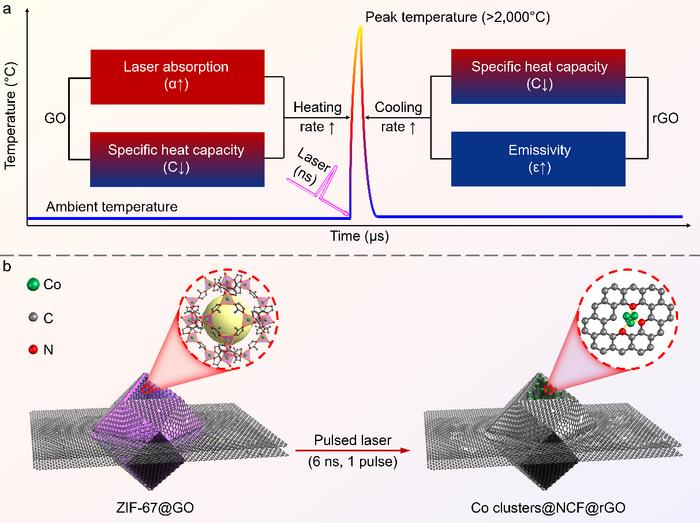This newly performed study has been headed by Professor Zhong-Qun Tian (Xiamen University) and Professor Kostya S. Novoselov (National University of Singapore).

The GCURH method is capable of providing a microseconds scale of high-temperature pulse with a heating/cooling rate of 109 °C/s, and thus be applied to precisely synthesis of sub-nanometer metal cluster catalysts with high metal loadings. Image Credit: ©Science China Press
Having been sourced from the ultrafast laser-to-thermal conversion capacity and the impermeable, adaptable features of graphene, Dr. Ye-Chuang Han (primary author) and Professor Zhong-Qun Tian invented the concept and selected graphene as the diffusion-constrained nanoreactor available for high-temperature reactions.
In one pulse of nanosecond laser irradiation, they discovered that the irradiated area of graphene obtains an astonishingly high heating or cooling rate of 109 °C/s, and referred to the heating technique as graphene-confined ultrafast radiant heating (GCURH).
Moreover, through the partnership with Dr. Jun Yi (co-first author) and Professor Kostya S. Novoselov, the researchers executed the theoretical calculations and discovered that such an ultrafast cooling process is in line with Stefan-Boltzmann law, and radiation turns out to be the main mode of energy release at very high temperatures.
Thermally activated ultrafast diffusion, collision, and combination of metal atoms are basic processes for synthesizing burgeoning subnanometer metal clusters, and no technique has enabled the kinetically controllable synthesis of subnanometer metal clusters without compromising on metal loading.
Dr. Ye-Chuang Han and Dr. Beibei Pang (co-first author, University of Science and Technology of China) illustrated that the kinetics-driven GCURH method has the potential to synthesize subnanometer Co cluster catalysts with high metal loading up to 27.1 wt%.
This can be done by pyrolyzing a Co-based metal-organic framework in just microseconds, thereby constituting one of the biggest size-loading combinations and the most rapid rate for MOF pyrolysis in the reported literature.
On the whole, this work offers a general plan to defeat the trade-off present between ultrasmall size and high loading in metal cluster catalysts. Also, it carries great promise for the forthcoming industrial applications of cluster catalysts.
Journal Reference
Han, Y-C., et al. (2023) Graphene-confined ultrafast radiant heating for high-loading subnanometer metal cluster catalysts. National Science Review. doi.org/10.1093/nsr/nwad081.